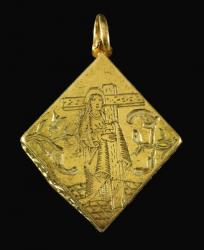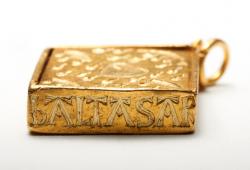INSTITUT SUPERIEUR D'ANTHROPOLOGIE
INSTITUTE OF ANTHROPOLOGY
ONLINE COURSES / COURS A DISTANCE
OPEN COURSE : FEBRUARY 2013
HRM 104 : INTRODUCTION TO INTANGIBLE CULTURAL HERITAGE
REGISTER NOW
ROYAUME UNI – 
 Hockley - A chance discovery in an Essex field by a four year-old boy has led to the latest addition to the British Museum’s medieval collection. Beautiful, both in its simplicity and elegance, the Hockley Pendant is a diamond-shaped reliquary dating from the beginning of the sixteenth century, and would have been worn by a wealthy individual as a discreet statement of piety. The decoration on this piece reveals the dual nature of religious jewellery in the early sixteenth century, as a decoration and a holy amulet. The pendant is an excellent example of the intertwining of the secular and the religious in the Middle Ages. The front shows a sombre Saint Helena supporting the cross, while the back shows the Five Wounds of Christ, from his hands, feet and heart. Around the rim are inscribed the names of the Three Magi (or Wise Men): Casper, Melchior and Balthazar. At just over three centimetres high, the pendant displays a stunning level of evocative detail. The cross shows flecked grains of wood and the Five Wounds of Christ weep blood shaped like tears, which rain down the pendant. Originally the pendant would have looked slightly different, with the flowers, wounds and names of the Magi all filled with painted enamel. This interplay between gold and enamel was a particularly dramatic feature of late medieval metalwork, and gives us an indication of the high level of skill involved in creating such an intricate piece of jewellery. The interior of the pendant is now empty, but it would once have held a relic, possibly of the True Cross, which was said to have been brought by St Helena to Constantinople from the Holy Land, and was thought to be the cross on which Christ was crucified. This object allows us to better understand the enduring physical relationship between the living and the dead in the Middle Ages and the amazing depth and vibrancy of the material culture from this fascinating period in history.
Hockley - A chance discovery in an Essex field by a four year-old boy has led to the latest addition to the British Museum’s medieval collection. Beautiful, both in its simplicity and elegance, the Hockley Pendant is a diamond-shaped reliquary dating from the beginning of the sixteenth century, and would have been worn by a wealthy individual as a discreet statement of piety. The decoration on this piece reveals the dual nature of religious jewellery in the early sixteenth century, as a decoration and a holy amulet. The pendant is an excellent example of the intertwining of the secular and the religious in the Middle Ages. The front shows a sombre Saint Helena supporting the cross, while the back shows the Five Wounds of Christ, from his hands, feet and heart. Around the rim are inscribed the names of the Three Magi (or Wise Men): Casper, Melchior and Balthazar. At just over three centimetres high, the pendant displays a stunning level of evocative detail. The cross shows flecked grains of wood and the Five Wounds of Christ weep blood shaped like tears, which rain down the pendant. Originally the pendant would have looked slightly different, with the flowers, wounds and names of the Magi all filled with painted enamel. This interplay between gold and enamel was a particularly dramatic feature of late medieval metalwork, and gives us an indication of the high level of skill involved in creating such an intricate piece of jewellery. The interior of the pendant is now empty, but it would once have held a relic, possibly of the True Cross, which was said to have been brought by St Helena to Constantinople from the Holy Land, and was thought to be the cross on which Christ was crucified. This object allows us to better understand the enduring physical relationship between the living and the dead in the Middle Ages and the amazing depth and vibrancy of the material culture from this fascinating period in history.
http://blog.britishmuseum.org/
USA – Brunswick - The city spent four months unearthing history. It will take two days to cover it back up. City Manager Bill Weeks said 37 graves dating from the late 1700s and early 1800s that were found in an archaeological dig are being re-covered with dirt. The plots are the remains of a Colonial-era burial ground at Wright Square on the city’s historic South End and a link to the city’s past. The burial ground was long known to exist but was only discovered when the old Glynn County Middle School was demolished. Four graves were found immediately, and 33 more were unearthed as excavation continued into the fall. “These certainly were the earliest inhabitants of Brunswick,” Weeks said as a bulldozer and dump truck worked at hauling and spreading dirt Wednesday. “When this burial ground was here, Brunswick was primarily a frontier town. There was no significant growth until the 1830s.” Weeks said he considers the site a burial ground rather than a cemetery.
http://jacksonville.com/news/georgia/2013-01-16/story/archaeological-dig-complete-brunswick-re-covering-centuries-old-burial?utm_source=feedburner&utm_medium=feed&utm_campaign=Feed%3A+JacksonvillecomMostPopularStories+%28Jacksonville.com%3A+Most+Popular+Stories%29
CHINE – Guduiqiao - Archaeologists have recently discovered a large number of potteries, oracle bones, arrows, and antlers from the Shang and Zhou dynasties during excavation of the Guduiqiao ruins in Weiqian village of Fucheng town, Fengyang county. It is the first time that archaeologists have excavated Shang and Zhou living vestiges at Guduiqiao in a systematic way. The ruins in Guduiqiao were discovered as a result of the County Archaeological Survey. The area served as a typical pier in the Shang and Zhou dynasties along the middle and lower reaches of the Huai River. It had never been systematically excavated before. This time, the Anhui Archaeological Institution and Wuhan University made joint efforts to launch the excavation. After three months of exploration beginning mid-September, archaeologists found that the Guduiqiao ruins were clearly divided according to functions. Among the 20,000-square-meter area of pier relics, over 300 sq m have been excavated. The ruins can be divided into two zones: a living zone and work zone. In the living zone, archaeologists discovered a large amount of utensils for daily use such as terrines and potteries. In the work zone, they found copper residue and relics of ceramic molds for copper casting. They also found multifarious precious cultural relics like potteries, oracle bones, antlers and bronzeware. During the excavation, archaeologists found bronzeware such as copper arrowheads. After enduring 3,000 years of wear and tear, they are still as sharp as when they were created. What's more, they also found accessories like antlers, animal bones, bone hairpins and stone relics. Dozens of oracle turtle shells and oracle bones were also found, a significant amount for historical excavations in Anhui.
http://www.kaogu.cn/en/detail.asp?ProductID=3847